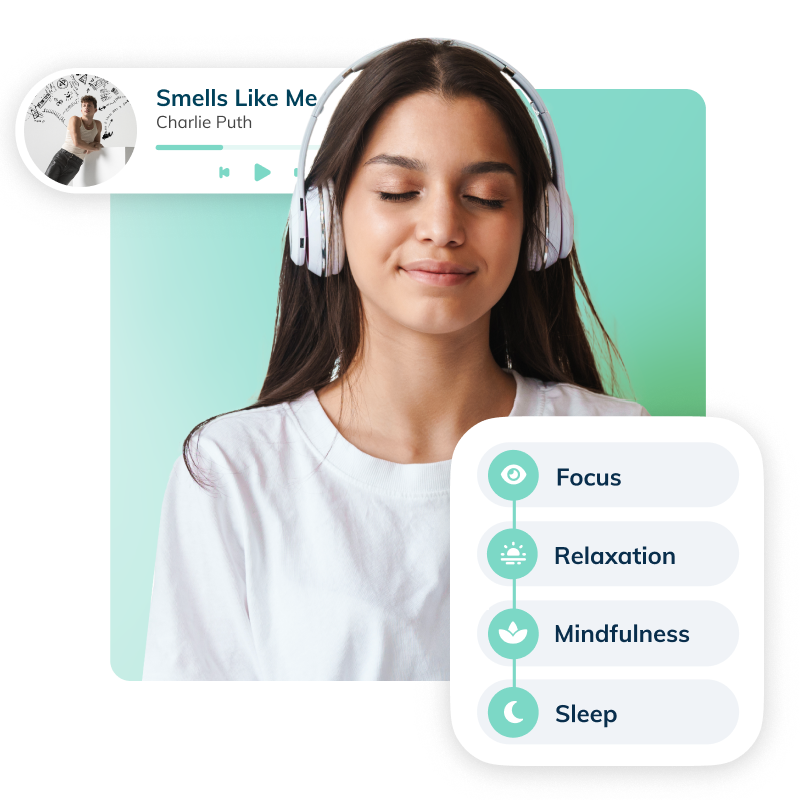The Science Behind Wellness Music
Scientists, artists, and enthusiasts have long understood that music is an important and integral aspect of human nature. Scientific and technological advances have developed our understanding about how many of the features of music that we know and love— its emotional effects, its capacity to deliver rewards, and its ability to bring people together—are rooted in specific mechanistic effects of music on the brain.
Importantly, the discoveries underlying this progress have been made by focusing on “musicality” rather than music itself. A common (and reasonable) question when it comes to the biological effects of music is, “doesn’t everybody like something different?”
After all, music is a cultural phenomenon of ever-expanding diversity; some people prefer folk music while others choose death metal. But music and its effects are highly structured. Biomusicology focuses on what’s held in common: human musicality, the genetically constrained and reliably developing set of capacities that allow us to produce and perceive music.
There are at least four areas of human musicality that are of major importance in understanding applications of music for wellness: tonality, rhythm, reward, and social connection.5
Tone
Vocal similarity theory (VST) holds that we perceive tones in music in the same way that we perceive tones in the human voice.6,16,27 Tones are sounds that have a clear pitch. The human voice has been the primary source of our experience with tones for as long as we’ve been a species. At an individual level, this experience begins in the womb, with the sound of our mother’s voice. These facts combine to make our brains extremely sensitive to the emotional nuances of the voice, and the tones that it contains broadly. When we hear tones in music, our brains process them in the same way, taking in melody and harmony and feeling what they communicate.
This helps us understand why and how music can evoke such powerful emotional responses—at times bringing us to tears, or alternately, filling us with joy. Importantly, it also provides us with guidance for how music can be used to systematically promote specific physiological and emotional responses.
In short, tones must be organized in a way that distills and exaggerates the properties of a calming, soothing voice.
The guidance provided by VST generally corroborates the intuitions of musicians and music therapists in long-held traditions of using music to change how people feel. This is combined with clear evidence that music can have important clinical benefits. Taking anxiety as an example, multiple large-scale meta-analyses of randomized controlled trials indicate that music interventions drive clinically significant reductions in anxiety.17,19 Similar clinical benefits on mood are observed in the context of depression.1,25
.png?width=1002&height=550&name=Branded%20Stock_Smart%20(7).png)
Rhythm
Like tone, rhythm is a fundamental component of musicality with powerful effects on the brain that can be harnessed for wellness purposes. Interestingly, humans exhibit a tendency to move in response to rhythm, tapping or bobbing along, often spontaneously and without conscious intent. This tendency and the general entraining effects of music are captured by Neural Resonance Theory (NRT) which holds that rhythm perception relies on the entrainment of neural responses to sound.9,18,28
The sensitivity to rhythm is not exclusively related to music; in fact, its primary function may be in the processing of spoken language.22 In this way rhythm perception, like tone perception, is also deeply connected to how our brains contend with human voices and the information they convey.
NRT also describes how rhythm can couple together brain activity in parts of the brain that deal with sound and movement (even if you’re not moving), including central subcortical structures involved in motivation and reward. The close association between music and movement has been further studied in the context of groove, a term from the psychology of music that reflects how much music makes you want to move or dance. Certain musical features are consistently associated with music that rates as groovy, including strong low-frequency energy, or “bass,” and moderate levels of syncopation.
Being in a musical groove is widely associated with positive affect: feeling groovy = feeling good.
The powerful effects of rhythm to supply motivation and energy, and make you feel good have long been implemented in the traditional songs used by various cultures as an accompaniment to physical labor and work, as a means of lifting spirits, coordinating efforts, and providing positive distraction from the monotony of a task. Sailors’ sea shanties are a well-known example of this, and work songs were also commonly sung by cowboys, railroad workers, agricultural workers, and textile workers, among others.12
The same elements of rhythmic music that make it useful for physical work can be adapted and transferred to work that is less physical in nature but nonetheless demands sustained focus, particularly routine tasks that we manage on a daily basis, often on a computer (e.g., answering email messages or organizing data). Music for focus has to strike a balance between keeping the listener alert and engaged with motivation and groove, but not so much that they jump out of their chair and start dancing.

Reward
All that feel-good energy from music stimulates the brain’s reward circuitry, causing the release of dopamine,30 a neurotransmitter linked to volition, motivation, and drive, and endogenous opioids,20 which mediate pleasure and reinforcement. These systems are similarly engaged by primary reinforcers like food and sex, as well as drugs like cocaine and heroin, lending neurobiological reality to the old adage “sex, drugs, and rock and roll.”
Through stimulating the reward system, music can affect many aspects of our behavior and health and may have particular importance in normalizing brain reward function in a safe way to counteract depression, anhedonia, addiction, anxiety, and stress.

Social Connection
As mentioned earlier in the discussion of work songs, music has the power to bring people together, synchronizing movements and emotions to increase feelings of affiliation and social connection. Recorded music is only 150 years old. Prior to this, musical engagement was predominantly a social experience, as people sang together, played instruments together, or joined through dance or listening. This social context remains relevant even though it is now routine to experience music through personal headphones.
As a result, music can inspire a feeling of connection even when we’re alone, especially if it moves you to dance or sing along, and especially if it’s well-matched to how you feel emotionally. This positions music against feelings of loneliness and isolation.

.png)
.png?width=1001&height=550&name=Branded%20Stock_Smart%20(1).png)

.png?width=1002&height=550&name=Branded%20Stock_Smart%20(7).png)



.png)

